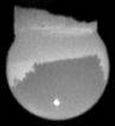This is a two-step procedure:
- Break off a piece of the melt during the
regular procedure.
- Let the separated melt fall onto a cold surface.
In step 2, a combination of gravity and electrostatic force
brings the falling melt body into swift, violent contact with a grounded
surface. Usually this surface is the stainless steel of the chamber
floor, but melt particles occasionally strike the electron source (glowing hot
tungsten) and produce triangular crystallites.
Step 1 is accomplished either through gravity acting on a
weak target or electrostatic stress applied by high voltage between the melt and the chamber.






Thick shells don't buckle completely under negative
hydrodynamic stress. Freestanding graphite
membranes of only several nanometers thickness are frequently observed
over pockmarks.
Because the melt cools as it flows, we can expect a graphitic
shell to precipitate on the interior of any pockmark. This shell will be
compressed as the melt solidifies and continues to precipitate carbon.
Apparently, enough compressive stress exists to frequently turn the graphitic
pockmark lining inside-out. The
electron-transparent bubbles seen on samples of splat-cooled iron, nickel
and cobalt are evidence of a resilient graphitic material.
Negative hydrodynamic stress under the top of the graphite
shell can cause the shell to buckle and form pockmarks. At the same
time, longitudinal rifts may appear in the shell, around its equator.
Upon impact with a cold surface, the melt droplet rapidly
deforms, cools and experiences non-uniform stress.
During freefall, the separated melt droplet briefly has the
opportunity to cool and thicken the graphite shell.







